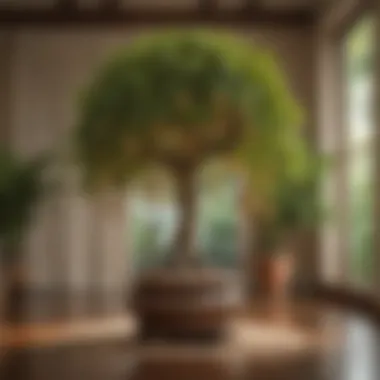Pachira Aquatica: The Money Tree Explained


Intro
The Pachira Aquatica, known widely as the Money Tree, carries a sway of cultural significance across many societies. This plant is not only familiar for its unique formation—which features a braided trunk and broad, green leaves—but also for its connection to prosperity and good fortune. Plant enthusiasts and interior decorators alike value its aesthetic appeal; the Money Tree is both visually striking and relatively easy to care for. In this article, we will explore its origins, care requirements, and the myths surrounding this remarkable houseplant.
Key Insights and Trends
Current Trends in Interior Design
Integrating greenery into living spaces has become a notable trend within modern interior design. Homeowners are increasingly looking for elements that combine style and livability. The braided trunk of the Money Tree serves as a captivating focal point, enhancing various styles from minimalistic to bohemian decor. Eye-catching, low-maintenance plants like the Money Tree fit perfectly in contemporary homes, contributing color and freshness.
Popular Gardening Technologies of the Season
Gardeners are embracing methods to cultivate healthy, thriving indoor plants. For the Money Tree, the demand for organic growing techniques is on the rise. Many are turning to natural fertilizers that enrich the soil without harmful chemicals. Additionally, hydroponics—a method of growing plants without soil—has gained popularity. This technique can produce robust plants and creates an innovative experience for plant lovers.
Practical Tips and How-To Guides
Step-by-Step Guides for Home Decoration Projects
- Choose the Right Spot: Place the Money Tree in a location that receives indirect sunlight. Direct sunlight can scorch the leaves.
- Select the Container: Opt for a pot with drainage holes to prevent root rot.
- Soil Selection: Use a well-draining potting mix to support healthy root development.
- Watering Schedule: Allow the top inch of the soil to dry out before watering again. Typically, watering every two weeks is sufficient.
Entertaining Tips and Planning Checklists
"In many cultures, placing a Money Tree in a prominent spot is believed to attract positive energy and wealth."
- Positioning the Plant: Position the Money Tree near entrances to enhance auspicious energy flow in your home or event space.
- Creating a Theme: Incorporate the Money Tree as part of your event design, aligning other decorations to match its natural look.
- Maintenance During Events: Ensure the plant is watered appropriately before events to maintain its vibrant appearance.
The Money Tree's presence can be more than just decorative; it can enhance the overall ambiance of your home while possibly bringing with it a degree of fortune and coincidence.
Prelude to Pachira Aquatica
The Pachira Aquatica, commonly referred to as the Money Tree, has garnered attention not just for its striking appearance but also for its perceived benefits in various cultural contexts. Understanding this plant's characteristics and significance offers insight into why it has become a popular choice among homeowners and interior design enthusiasts.
The importance of this introduction lies in laying a foundation on what Pachira Aquatica represents. It serves not only as a decorative piece but also as a symbol of fortune and prosperity in certain cultures. With its distinct braided trunk and large, glossy leaves, it is visually appealing while also easy to maintain. This balance of aesthetics and symbolism makes the Money Tree a preferred choice for those looking to enhance their living spaces with greenery, which has proven psychological benefits in promoting well-being and tranquility.
Botanical Overview
Pachira Aquatica belongs to the Malvaceae family, revealing its connection to other notable species like hibiscus and cacao. This tropical tree can reach heights of up to 60 feet in its natural habitat, but it is typically pruned and maintained at a smaller size for indoor placement. Its leaves, grouped in whorls, are palmate with five to seven leaflets each, contributing to its lush appearance. The plant produces striking, large flowers with long petals and a sweet aroma; however, such blooms are rare indoors.
The adaptability of Pachira Aquatica to various soil types and light conditions further emphasizes its suitability as a houseplant. This ease of care makes it particularly appealing to those who may not have a green thumb but wish to incorporate plant life into their environments.
Cultural Significance
Historically, the Money Tree holds diverse meanings across cultures. In Feng Shui, it is believed to bring wealth and good luck, making it a common gift during auspicious occasions. Its presence is thought to enhance positive energy flow, which is desirable in both homes and businesses.
In regions like Central America, where it is native, Pachira Aquatica is often associated with prosperity and financial stability. The cultural narratives surrounding this plant elevate its importance beyond mere decoration. Its symbolism can serve as a conversation starter and a centerpiece, promoting a sense of connection between nature and prosperity in daily life.
"A Money Tree is more than just a plant; it's a manifestation of hope for better fortune and success."
In summary, the introduction to Pachira Aquatica sets the stage for understanding its multifaceted role as both a decorative element and a cultural icon. In the following sections, we will delve deeper into its origins, care essentials, and the health benefits it brings to interiors.
Origins and Habitat
Understanding the origins and habitat of Pachira Aquatica is fundamental in appreciating not only its care needs but also its presence in various cultures. This section explores how its native environment shapes the way this plant grows, thrives, and even its symbolic meanings in different societies.
Native Range


Pachira Aquatica, commonly known as the Money Tree, originates from Central and South America. It can mainly be found in countries such as Brazil and the wetlands of the Amazon River basin. This plant is often located near water bodies like swamps and rivers. Its ability to adapt to such humid environments results in its lush foliage and rapid growth. This native range plays a crucial role in how the plant is perceived and cultivated around the world.
The natural habitat influences its care requirements significantly. In their native regions, Pachira Aquatica thrives in rich, loamy, and consistently moist soil. This suggests that homeowners should replicate these conditions when growing it indoors. Ensuring the right soil mix is vital for its health. Home gardeners may consider using a combination of potting soil mixed with perlite for aeration and drainage.
Natural Environment
In the wild, Pachira Aquatica flourishes in tropical climates characterized by substantial rainfall and warm temperatures. The water-drenched soil not only nourishes the plant but also contributes to its unique characteristics, such as its thick trunk swollen at the base, which acts as a reservoir for water. This adaptation allows it to survive during dry spells.
The temperature of its natural habitat can range from 20 to 30 degrees Celsius. Hence, the Money Tree prefers a similar environment when kept indoors. It should be sheltered from extreme cold and drafts, which can disrupt its growth process. Moreover, the humidity in its tropical habitat fosters lush growth and vibrant leaves. Therefore, homeowners in drier climates might consider using a humidifier or regularly misting the plant.
"Cultivating Pachira Aquatica successfully requires an appreciation of its roots and the environment to which it is naturally adapted."
This insight into its origins enhances appreciation for the plant's role not just as a decorative element, but also a living connection to the ecosystems of its native regions.
Physical Characteristics
Understanding the physical characteristics of Pachira Aquatica is essential for appreciating its role in home decor and horticulture. This plant not only adds beauty but also contributes positively to the indoor environment. The unique features of Pachira Aquatica make it a versatile fit for various living spaces. Its visual appeal, size, and structure serve practical functions in both aesthetic and acoustic realms.
Leaf Structure
The leaves of Pachira Aquatica are glossy and palmate, often described as resembling a hand with several fingers. Each leaf typically has five to seven leaflets, which are rich green in color. This leaf structure plays a critical role in the plant's overall health. It allows for efficient photosynthesis, directly affecting growth rates and resilience. The broad leaves also help filter indoor air pollutants, adding to its appeal for homeowners seeking cleaner air. Maintaining the leaves by regular cleaning and monitoring for pests will ensure the foliage remains vibrant and healthy.
Growth Patterns
Pachira Aquatica exhibits a moderate growth rate, with its height often reaching around six feet when grown in suitable indoor conditions. The plant generally grows vertically, developing a thicker trunk over time. Understanding the growth patterns can help homeowners create appropriate environments that foster healthy development. Optimal conditions for growth include well-draining soil, adequate light, and sufficient humidity. Knowing these patterns aids plant enthusiasts in planning their care routines and ensuring their plants thrive.
Braid and Trunk Formation
One of the most distinctive physical characteristics of Pachira Aquatica is the braided trunk, which is achieved by intertwining multiple stems during their early growth stages. This formation is not merely aesthetic; it also provides strength and stability to the plant. The thick trunk is indicative of maturity and can hold moisture and nutrients, making the plant more resilient to varying conditions. This structural feature enhances the plant's visual impact in any space, often becoming a conversation starter. Care should be taken to avoid mechanical damage to the trunk and to ensure it receives adequate support as it grows.
"The Money Tree not only serves as an attractive houseplant but also provides essential benefits for indoor living."
In summary, the physical characteristics of Pachira Aquatica are not just about looks. They encompass functional aspects that contribute to its value as a houseplant. By focusing on elements such as leaf structure, growth patterns, and trunk formation, one can better appreciate how Pachira Aquatica can enhance a home, both visually and environmentally.
Care and Maintenance
Caring for Pachira Aquatica is crucial for its health and longevity. Proper maintenance not only ensures that the plant thrives but also enhances its aesthetic value as a decorative element in homes. Understanding soil, watering, light, temperature, and fertilization not only helps the plant flourish but also improves the atmosphere of the space it occupies. Each component plays a vital role in sustaining the unique beauty of the Money Tree.
Soil Requirements
The soil for Pachira Aquatica must provide excellent drainage to prevent root rot. A good mix typically includes peat moss, pine bark, and perlite. These materials help retain moisture without suffocating the roots. Aim for a pH level between 6.0 and 7.0, leaning slightly acidic. A well-draining potting mix from brands like Miracle-Gro or FoxFarm works well for these needs.
Watering Practices
Watering is a significant part of plant care. For Pachira Aquatica, it is essential to let the topsoil dry out between watering. Overwatering can lead to yellowing leaves and root issues. During the growing season in spring and summer, water the plant thoroughly, ensuring excess water drains from the pot. In fall and winter, reduce watering frequency. It’s helpful to check the moisture level by sticking your finger into the soil about an inch deep.
Light Conditions
Pachira Aquatica prefers bright, indirect sunlight. Direct sunlight can scorch the leaves, leading to damage. A setting near a window covered by sheer curtains is ideal. If light conditions are suboptimal, the plant may grow leggy and fail to thrive. However, it can tolerate lower light for short periods, making it a versatile choice for various rooms.
Temperature Preferences
This plant does best in temperatures between 60°F and 75°F. Exposure to cold drafts or sudden temperature changes should be avoided, as they can negatively affect the plant's health. Consistency in temperature is imperative for preventing stress on the plant, which can lead to drop in leaves and overall deterioration in appearance.
Fertilization Schedule


Feeding is essential to promote growth. Use a balanced fertilizer during the growing months, typically every four to six weeks. Liquid fertilizers like Miracle-Gro Indoor Plant Food can be beneficial. In the dormant months of winter, fertilization should be minimized, as the plant's growth naturally slows. Over-fertilizing can lead to salt buildup, which may harm the roots.
Pachira Aquatica for Interiors
Integrating Pachira Aquatica, often referred to as the Money Tree, into interior spaces offers numerous advantages. This plant is not just visually appealing but also versatile in application. Its lush appearance can create a refreshing sense of nature inside urban environments. The importance of exploring Pachira Aquatica for interiors lies in recognizing how it contributes to the aesthetics and ambiance of a room, while also promoting emotional well-being.
Aesthetic Benefits
Pachira Aquatica serves as a striking decor element for various interior styles. Its broad leaves with a vibrant green color enhance a space's vibrancy without overwhelming it. The braiding of the trunk adds a unique texture that draws attention, making it a focal point in any setting. As a tropical plant, it imbues warmth, transforming sterile interiors into inviting environments.
- Complementing Styles: The Money Tree adapts well to both modern and traditional decors.
- Size Variety: Available in different sizes, it can fit in small apartments or larger homes.
- Visual Balance: Its symmetrical form can help balance other elements in a room, creating a cohesive look.
Incorporating this plant can lead to a more harmonious environment that promotes relaxation.
Incorporation into Design
Using Pachira Aquatica in interior design is not just about placing a plant in a corner. It involves thoughtful integration into the overall design scheme. Here are ways to incorporate it effectively:
- Statement Pieces: Place a large Money Tree in a living room or entryway to create an immediate impact.
- Grouping with Other Plants: Combine it with other houseplants of varying heights and textures for a dynamic arrangement.
- Planters and Containers: Select decorative pots that match the room's color palette or theme. Using textured or colored planters can further elevate the look.
- Lighting Considerations: Position the plant near natural light sources to enhance its growth while also showcasing its beauty.
"A well-placed Pachira Aquatica can not only uplift a room's style but also impact the mood of its inhabitants."
In summary, Pachira Aquatica is not just another houseplant; it is a valuable element in home design. Its aesthetic contributions and easy integration into various design schemes make it popular among homeowners and decorators alike. By understanding its benefits, one can create beautiful and serene spaces that reflect personal styles while fostering well-being.
Health Benefits of Pachira Aquatica
The exploration of Pachira Aquatica, or the Money Tree, reveals aspects beyond its visual appeal. This section focuses on the health benefits that enhance the quality of interior living. The importance of these benefits cannot be understated, as they contribute to both physical and mental well-being, making the Money Tree a worthy addition to various home environments.
Air Purification
Pachira Aquatica has garnered attention not only for its aesthetic appeals but also for its intrinsic ability to improve indoor air quality. Houseplants, in general, are known to absorb pollutants, and the Money Tree is no exception. Through photosynthesis, Pachira Aquatica takes in carbon dioxide and releases oxygen, a fundamental process that promotes a fresher atmosphere. This is particularly helpful in urban settings where air quality might be compromised.
The specific air purification capabilities relate to the plant's efficiency in removing common toxins found in homes, such as formaldehyde and benzene. When placed strategically in living spaces, the Money Tree can significantly contribute to a reduction of indoor air pollutants. The actual effectiveness of this purification depends on factors such as the size of the plant, the number of plants present, and the overall room dimensions. An increased density of plants can compound the positive effects, creating a notable difference in air clarity.
"Adding a few well-placed plants can transform indoor air and enhance well-being beyond mere decoration."
Psychological Impacts
Beyond the physical benefits associated with air purity, Pachira Aquatica impacts psychological health in multiple ways. The presence of greenery indoors can foster a sense of tranquility. Studies indicate that the mere sight of plants can induce a calming effect, lowering stress levels and promoting mental clarity. This aspect is particularly relevant for individuals who seek a serene environment, whether for work or relaxation.
Moreover, taking care of plants can act as a therapeutic outlet. Engaging in gardening activities and nurturing plant life fosters a sense of responsibility and achievement. For many, keeping a Pachira Aquatica can create a routine that encourages mindfulness and a connection to nature, even in a confined urban setting.
In addition, introducing the Money Tree into interior design is associated with various cultural beliefs that posit plants as centers of good fortune and positive energy. This integrates an element of optimism into the household, which can further enhance the occupants' sense of well-being. The synergy of air purification and psychological benefits presents Pachira Aquatica as more than just a decorative item but as a contributor to a healthier and happier living space.
Common Myths and Misconceptions
When discussing Pachira Aquatica, also known as the Money Tree, it is crucial to address common myths and misconceptions surrounding this beloved plant. These beliefs can influence how individuals perceive its value and care requirements. Misunderstandings about the Money Tree can lead to improper care, potentially harming the plant's health. Moreover, the cultural significance tied to fortune and luck often overshadows practical aspects of its care.
Fortune and Luck Beliefs
The Money Tree is often associated with various beliefs about luck and prosperity. Many cultures, especially in East Asian traditions, regard the plant as a symbol of good fortune. This is one of the reasons it has gained popularity in homes and workplaces. Some claim that the braided trunk enhances its ability to attract financial luck.
However, it’s essential to clarify that these beliefs, while culturally rich, do not have empirical support. Relying solely on the idea that placing a Money Tree in your home will lead to wealth is a misconception. Instead, consider the plant as one part of a broader approach to creating positive change in your living environment. Acknowledging these myths is important, but it is equally critical to engage in practical actions that support financial wellness.
Plant Care Misunderstandings


Another area riddled with misunderstanding is the care of Pachira Aquatica. One common misconception is that the plant requires extensive care or specialized growing conditions. In reality, it is quite robust and can thrive in various environments if its basic needs are met.
For instance, many believe that Money Trees must be watered frequently. However, overwatering can lead to root rot, a serious issue for Pachira Aquatica. Instead, it is advisable to allow the soil to dry out between waterings.
Additionally, some assume that the Money Tree can flourish in low-light conditions. While it is adaptable, it still thrives best with indirect sunlight.
Other common misunderstandings include:
- Fertilization Myths: Many think excessive fertilization improves growth. In fact, this can harm the plant.
- Temperature Sensitivity: People often avoid keeping it near windows. However, it generally adjusts well to indoor temperature fluctuations.
These common myths can lead to unnecessary stress for the plant owner. Understanding the real needs of the Pachira Aquatica can significantly enhance both its growth and the owner's satisfaction.
Troubleshooting Common Issues
Addressing common issues that arise with the Pachira Aquatica, or Money Tree, is crucial for maintaining its health and aesthetic appeal. Identifying and solving problems early can prevent more severe consequences, ensuring that this popular houseplant continues to thrive in your home. Whether you are a seasoned gardener or a novice plant parent, understanding how to deal with these issues will enhance your experience with this striking plant.
Pest Management
Pests can pose a significant threat to the health of your Pachira Aquatica. Common pests that may affect this plant include spider mites, aphids, and mealybugs. These pests often attack the leaves and stems, leading to discoloration or wilting.
To manage these pests, regular inspections are vital. Look for signs of infestation, such as webbing or sticky residue. If you notice pests, here are some effective management strategies:
- Isolate Infected Plants: To prevent pests from spreading, move the affected plant away from others.
- Manual Removal: If the infestation is mild, use a soft cloth or cotton swab dipped in alcohol to remove pests.
- Insecticidal Soap: This is an eco-friendly option. It suffocates insects while being safe for the plant.
- Neem Oil: Applying neem oil can discourage further infestations due to its natural insect-repelling properties.
With diligence, you can keep pests at bay and maintain the beauty of your Money Tree.
Diseases and Solutions
Diseases can also affect Pachira Aquatica, often caused by Poor care practices or environmental factors. The most prevalent diseases include root rot and leaf spot, which can severely diminish the plant's health.
Root rot usually occurs when the plant is overwatered or planted in poorly draining soil. Symptoms may include yellowing leaves or a mushy stem. To address root rot, consider these steps:
- Assess Watering Practices: Adjust your watering routine to allow the soil to dry out between waterings.
- Repotting: If the roots appear mushy, remove the plant from its pot, cut away the rotten roots, and plant it in fresh, well-draining soil.
Leaf spot is typically a fungal or bacterial disease presenting as brown or black spots on the leaves. Solutions include:
- Proper Air Circulation: Ensure the plant is not crowded so air can flow freely around it.
- Fungicidal Treatment: If the problem persists, consider using a fungicide according to the manufacturer's instructions.
By taking proactive measures to address pests and diseases, you will ensure the health and longevity of your Pachira Aquatica, keeping it vibrant and flourishing in your living space.
Understanding the common issues faced by your Money Tree is essential for effective plant care. Regular monitoring and timely actions can protect your investment in this beautiful houseplant.
The End
In discussing Pachira Aquatica, it’s crucial to understand the resonance this plant has beyond mere aesthetics. The Money Tree is not only an attractive addition to any interior space but also embodies a tapestry of cultural significance and practical benefits. From its origins in Central and South America to its revered status in various traditions, the Pachira Aquatica serves multiple roles in a home.
Importance of the Ending
The conclusion consolidates the insights covered in the article. It highlights how the Pachira Aquatica can enhance personal well-being while serving decorative purposes. Emphasizing its health benefits, such as air purification and psychological impacts, showcases its dual nature as both a plant and a contributor to a serene environment.
Moreover, it is necessary to outline the care practices essential to maintaining a thriving Money Tree. Understanding the right soil, watering habits, and light conditions contributes significantly to the successful integration of this plant into daily life.
In an era where indoor environments profoundly affect mental and physical health, Pachira Aquatica stands out as an ideal choice for homeowners and gardening aficionados alike. Incorporating this plant can be a lifestyle decision that positively impacts the home and mind.
Final Thoughts on Pachira Aquatica
Pachira Aquatica invites us to re-evaluate our approach to interior design, advocating for a deeper connection to nature. Observing its growth, tending to its care, and appreciating its presence can all foster mindfulness and tranquility in our homes. This plant is more than just a piece of decor; it represents a bridge between nature and the built environment.
"Incorporating Pachira Aquatica is a step toward a harmonious living environment."
As homeowners, interior design enthusiasts, and gardening lovers contemplate their spaces, Pachira Aquatica proves to be a worthy consideration.



